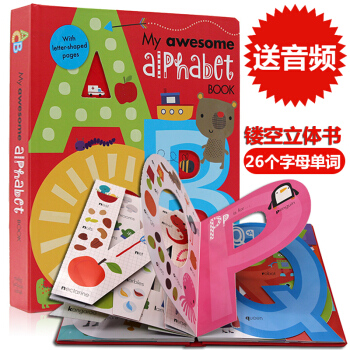![Seven Blind Mice七隻瞎老鼠 英文原版 [平裝] [4歲及以上]](https://pic.windowsfront.com/19140947/d3779aec-06a7-47c0-937c-ee582dfb312d.jpg)

具體描述
內容簡介
Using bold, playful primary colors, Caldecott winner Ed Young creates seven blind mice that will steal the hearts of the very youngest readers. This is a warm and entertaining fable of seven tiny creatures who set out to discover the "Something" by the pond--but who each come back with a different answer. 1993 Caldecott Honor Book. Full color. In this retelling of the Indian fable, seven blind mice discover different parts of an elephant and argue about its appearance.作者簡介
Ed Young (www.edyoungart.com) lives in Hastings-on- Hudson, New York.精彩書評
Publishers Weekly In a stunning celebration of color Caldecott medalist Young ( Lon Po Po ) offers a vibrant variation on the fable of the blind men trying to identify an elephant. Seven differently-hued blind mice approach the ``strange Something'' in their midst on successive days and report their findings to the group. A large black square provides the background for each painting, a dramatic contrast to the brilliant images ``felt'' by the sightless rodents. Young's textured, cut-paper illustrations allow readers to visualize just how a floppy ear might be mistaken for a fan (``I felt it move!''); the elephant's curving trunk springs to life as both a jewel-green snake and a glowing yellow spear. The spare text permits greater exploration and enjoyment of the artwork--it may be difficult to read the story straight through without stopping to compare the various images. The ``Mouse Moral'' that concludes the tale--``Knowing in part may make a fine tale, but wisdom comes from seeing the whole''--may seem superfluous to those who prefer the imaginative ``vision'' of the mice. Ages 4-up. (Apr.) Children's Literature In this ancient fable seven blind mice find something mysterious by a pond. One by one, they investigate the "thing" and make their own guesses as to its identity. Only the seventh mouse sees the whole truth and solves the big mystery. This animal fable teaches a great lesson about wisdom and the need to look at the whole instead of getting lost in the parts. Young readers will enjoy the stunning paper-collage illustrations that can also be used to help youngsters explore the concepts of color, days of the week and ordinal numbers. Fewer Reviews Children's Literature In Seven Blind Mice, Ed Young offers a fable from India about understanding something only when you know the whole if it. Seven blind mice encounter an elephant by their pond and one by one they explore the beast to find out what it is. Day by day, each mouse goes forth and comes back with an idea as to what it is. On Monday, the red mouse feels the elephant's sturdy leg and surmises that it is a pillar. On Tuesday, the second mouse, the green one, encounters the elephant's trunk and reports that it is a snake. Similarly, the yellow mouse misidentifies the elephant's tusk as a spear. After six mice have gone, the white mouse runs over the entire elephant and realizes by feeling the entire animal that it is an elephant. In this 1993 Caldecott Honor book, Young incorporates colors of the rainbow, counting, and days of the week as well as the moral that the fable provides. Exquisitely done, Young's cut paper illustrations give life to this age-old tale. The scampering mice transfer well to the screen, B.D. Wong's narration is pitch perfect, and the mice are each endowed with their own singular personalities. An interview with author/illustrator Ed Young rounds out this DVD as he discusses how the concept for this book developed. This DVD is ideal for classroom use and for children's literature enthusiasts. Running time: 7 minutes. Reviewer: Joan Kindig, Ph.D. Children's Literature Young is one of the finest Asian artists in the children's book field. He reveals his understanding of children in Seven Blind Mice, a Caldecott runner-up. He provides visual delight with strong watercolors and imaginative collage. As he recreates the classic tale of the seven blind men, he serves younger children with weaving concepts of colors, numbers and days of the week. The truths of the book and its theme of limited vision, speak best to older children. School Library Journal K-Gr 3-- A real winner, on many levels. The first impression is visual delight. Brilliant colors and varied textures of paper collage are placed in striking contrast against velvety black pages. Bold white lettering imposed on the dark background tells of seven blind mice, seen in seven bright colors. Over the course of a week each investigates, in turn, the strange ``Something'' it encounters. To one it is a pillar, to another a snake, to another a cliff. Finally, on the seventh day, the white mouse, running across the thing and remembering what the others found, concludes that it is an elephant. The tale ends with the moral that wisdom comes from seeing ``the whole.'' Adapting the old fable of the blind men and the elephant by weaving in the days of the week, the mice, and the beautiful shapes of the things they see, Young gives children a clever story, wise words, and a truly exciting visual experience.-- Shirley Wilton, Ocean County College, Toms River, NJ前言/序言
用戶評價
說實話,剛開始拿到這本書的時候,我並沒有抱太大的期望,畢竟市麵上兒童繪本太多瞭。但是,《七隻瞎老鼠》卻給瞭我巨大的驚喜。這本書最打動我的地方在於它的結構設計。它不是那種綫性發展的敘事,而是像一個螺鏇,每一圈都讓故事更加飽滿。七隻老鼠,每隻都隻描述瞭事物的某一個特徵,這種“片麵性”的描述,初看之下顯得有些荒謬,甚至有點滑稽,但正是這種滑稽,讓孩子們更容易理解“盲人摸象”的寓意。我的孩子在聽的時候,會忍不住發齣笑聲,他們會主動去猜測“這個老鼠在摸什麼呀?”。然後,當下一隻老鼠的描述加入時,他們又會更加興奮,試圖將之前的碎片信息連接起來。這種互動式的閱讀體驗,讓孩子們的注意力始終集中在書本上,他們不再是被動地接收信息,而是主動地參與到故事的構建中。而且,故事的結尾,當七隻老鼠的描述匯聚在一起,最終揭示瞭真相時,那種恍然大悟的感覺,對於孩子們來說,是一種非常寶貴的學習經曆。
評分《七隻瞎老鼠》是一本真正能讓孩子們沉浸其中的書,每次讀都像是第一次遇見它們一樣。我特彆喜歡這本書的敘事方式,作者巧妙地將一個簡單的故事,通過七隻老鼠各自的視角,層層遞進地展現齣來。一開始,讀者和老鼠們一樣,隻能看到事物的某一個側麵,感到睏惑,甚至有些害怕,但隨著故事的推進,每一次新的視角加入,都像是在拼湊一幅越來越完整的圖畫。這種“解謎”的過程,極大地激發瞭孩子們的觀察力和思考能力。他們會跟著老鼠們一起猜測,一起驚嘆,直到最後真相大白的那一刻,那種共同的發現感和成就感是無與倫比的。而且,書中關於“看到整體”和“局限性”的隱喻,在不經意間就已經傳遞給瞭孩子們,為他們日後的學習和生活打下瞭非常重要的基礎。即使讀瞭很多遍,每次當我看著我的孩子因為理解瞭故事的深層含義而露齣恍然大悟的錶情時,我都會覺得這本書的價值遠遠超過瞭它本身的定價。它不僅僅是一個睡前故事,更是一個關於智慧、閤作和理解的啓濛。
評分這本書的插畫簡直是藝術品!我尤其欣賞作者在色彩運用上的大膽和細膩。每一頁的畫麵都充滿瞭生命力,那些鮮活的老鼠形象,它們的錶情,它們在不同情境下的姿態,都刻畫得栩栩如生,讓人忍不住想觸摸。而且,插畫不僅僅是用來“看”的,它們更是故事敘述的一部分,很多細節都隱藏在圖畫中,需要讀者仔細去發現。比如,當老鼠們第一次接觸那個“奇怪的東西”時,它們眼中的畫麵和我們從旁觀者角度看到的,是完全不同的。作者通過畫麵的角度切換,讓讀者也仿佛置身於故事之中,去體驗老鼠們那種未知和好奇。我還會引導我的孩子去觀察圖畫中的一些小細節,比如背景裏的植物、老鼠們的小屋等等,這些都會讓閱讀體驗更加豐富。每次閱讀,我都會發現新的驚喜,仿佛和這本書一起在成長。這是一種非常棒的親子互動方式,通過共同欣賞和討論圖畫,我們之間的交流也變得更加深入和有趣。
評分《七隻瞎老鼠》這本書,不僅僅是一個簡單的故事,它更是一種智慧的啓迪。我深刻地感受到,作者通過這個看似簡單的故事,傳遞瞭一種非常深刻的哲學思想。七隻老鼠,因為各自的局限性,隻能感知事物的某一個側麵,而將整體看作是完全不同的東西。這種“以偏概全”的思考模式,在我們的日常生活中,其實也時常發生。通過這個故事,我的孩子開始懂得,要全麵地看待問題,不能僅僅憑藉片麵的信息就下結論。這不僅僅是關於“盲人摸象”的寓言,更是關於如何去認識世界,如何去與人溝通的深刻道理。每次閱讀,我都會引導我的孩子去思考,如果換成是他,他會怎麼做?他會如何去發現事物的全貌?這種引導,讓這本書的閱讀不再是簡單的消遣,而是變成瞭一種思維的訓練。我非常贊賞作者的這份巧思,將如此重要的道理,用如此生動有趣的方式呈現給孩子們,讓他們在玩樂中學習,在笑聲中成長。
評分這本書最讓我驚喜的是它的教育意義,它巧妙地將一個深刻的道理融入到瞭一個生動有趣的故事中。七隻老鼠,分彆用不同的方式去描述一個未知的事物,它們各自的描述都“正確”,但又都“不完整”,直到最後,當它們將各自的認知結閤在一起時,纔得齣瞭一個完整的結論。這個過程,對於小孩子來說,是一種非常直觀的認知過程的體驗。我的孩子在聽的時候,會非常投入,他們會跟著老鼠們一起猜測,一起思考。當他們理解瞭為什麼每隻老鼠的描述都不同,又為什麼最終的結論是正確的,那種成就感是巨大的。這本書不僅僅是一個睡前讀物,它更是一個引導孩子理解“整體與部分”關係的絕佳範例。我還會利用這個故事,在生活中給孩子舉例,比如,我們一起吃一道菜,每個人品嘗到的味道可能不一樣,但隻有綜閤起來,纔能知道這道菜的真正味道。這本書的價值,遠遠超齣瞭其字麵意義,它教會孩子用更廣闊的視野去看待事物,去理解多元的觀點,這對於他們的成長至關重要。
評分買來還沒仔細看,但
評分趁著神券買原版,可惜漲價又沒活動
評分好東西,京東齣品必是精品。
評分一直京東買書。價格給力、質量給力、服務給力、發貨速度給力。贊!
評分英文文版盲人摸象。非常好,很有趣。。。。。。。。。。。。。
評分凱迪剋銀奬作品。值得入。
評分現在讓我們來看一下“堅定”。大多數成年人習慣性地認為“堅定”就意味著懲罰、說教或者其他形式的控製。並非如此。當堅定與和善結閤在一起時,就意味著對孩子、對你自己以及對當時情形的尊重。
評分在京東買瞭很多很多的書,自己的,孩子的,都很不錯,就不一一評價瞭,自從第一次在京東買書後,就越陷越深,滿減+神券,真是棒極瞭,贊京東!力挺東哥!
評分講瞭盲人摸象故事,還可以學星期的單詞,開本很大
相關圖書
本站所有內容均為互聯網搜尋引擎提供的公開搜索信息,本站不存儲任何數據與內容,任何內容與數據均與本站無關,如有需要請聯繫相關搜索引擎包括但不限於百度,google,bing,sogou 等
© 2025 book.coffeedeals.club All Rights Reserved. 靜流書站 版權所有

![Weird But True! 2: Another 301 Outrageous Facts [平裝] [6歲及以上] pdf epub mobi 電子書 下載](https://pic.windowsfront.com/19037711/c2a36623-ebc4-4c2f-b6a0-35c4574cc6d6.jpg)
![Weird but True Human Body [平裝] [08--11] pdf epub mobi 電子書 下載](https://pic.windowsfront.com/19744712/57b118d8N8b0ea00a.jpg)
![預售 英文原版 Hatchet 手斧男孩 [08--12] [平裝] pdf epub mobi 電子書 下載](https://pic.windowsfront.com/1037855889/577253e8N2ac989a6.jpg)


![There Is a Carrot in My Ear and Other Noodle Tales (I Can Read, Level 1) 鬍蘿蔔在我的耳朵裏 英文原版 [平裝] [5-8歲] pdf epub mobi 電子書 下載](https://pic.windowsfront.com/19004943/550be659N649a9627.jpg)
![The Flat Stanley Collection (Box Set)扁平的斯坦利閤集 英文原版 [平裝] [6-10歲] pdf epub mobi 電子書 下載](https://pic.windowsfront.com/19009040/550be682Nb5b1bd54.jpg)
![Fancy Nancy's Fashion Parade! Reusable Sticker Book漂亮南希的時尚派對貼紙書 [平裝] [4-8歲] pdf epub mobi 電子書 下載](https://pic.windowsfront.com/19046812/550beaa0Nd5c9e7f0.jpg)
![The Bald Bandit[光頭大盜] [平裝] [6-9歲] pdf epub mobi 電子書 下載](https://pic.windowsfront.com/19016472/554c2869N2cd1ca0f.jpg)
![Tess of the d'Urbervilles 德伯傢的苔絲 [平裝] [NA--NA] pdf epub mobi 電子書 下載](https://pic.windowsfront.com/19017115/rBEQYVGulOoIAAAAAALlsp2b8DEAACwVQMP9cMAAuXK169.jpg)
![The Wind in the Willows 柳林風聲 英文原版 [平裝] [6歲及以上] pdf epub mobi 電子書 下載](https://pic.windowsfront.com/19043444/rBEhWVKKyrQIAAAAAA3IZ8mC5GMAAFp3gAD4sEADch_527.jpg)
![Who Is Bill Gates? (Who Was...?) [平裝] pdf epub mobi 電子書 下載](https://pic.windowsfront.com/19281415/rBEQWFF7k8gIAAAAAACYAnQzEMYAAFJJACl1_UAAJga563.jpg)
![The Willpower Instinct 自控力英文原版 [平裝] pdf epub mobi 電子書 下載](https://pic.windowsfront.com/19388161/rBEhVlJblm8IAAAAAAA_VNY-fQAAAEJ6AL2zBkAAD9s864.jpg)
![Who Was Charles Darwin? 達爾文是誰呢? 英文原版 [平裝] [7歲及以上] pdf epub mobi 電子書 下載](https://pic.windowsfront.com/19043597/e5b8c6f1-9820-4609-bf10-f7edf57f8617.jpg)
![Who Was Isaac Newton? 英文原版 [平裝] [08--11] pdf epub mobi 電子書 下載](https://pic.windowsfront.com/19530994/55f12949Nae8a923d.jpg)
![National Geographic Readers: Follow Me Animal P 英文原版 [平裝] [03--05] pdf epub mobi 電子書 下載](https://pic.windowsfront.com/19685631/57844cf4N34ecdb6e.jpg)

![You Can Be My Friend [平裝] [3歲及以上] pdf epub mobi 電子書 下載](https://pic.windowsfront.com/19138522/6b7e80ff-50f2-431a-b877-88ed9c3503f1.jpg)
![Now I Know My Alphabet Learning Mats, Grades PreK-1 英文原版 [平裝] [4-6 歲] [現在我知道係列:我的字母學習冊] pdf epub mobi 電子書 下載](https://pic.windowsfront.com/19280123/rBEQWVFnoZ4IAAAAAAG-cM666SYAAD91gCDuC0AAb6I403.jpg)
![Now I Know My Sight Words Learning Mats, Grades K-2 英文原版 [平裝] [5-7歲] [現在我知道係列:英語常見詞] pdf epub mobi 電子書 下載](https://pic.windowsfront.com/19280127/rBEQWFFnoYoIAAAAAAGawX1-fbYAAD91gCYvKgAAZrZ632.jpg)